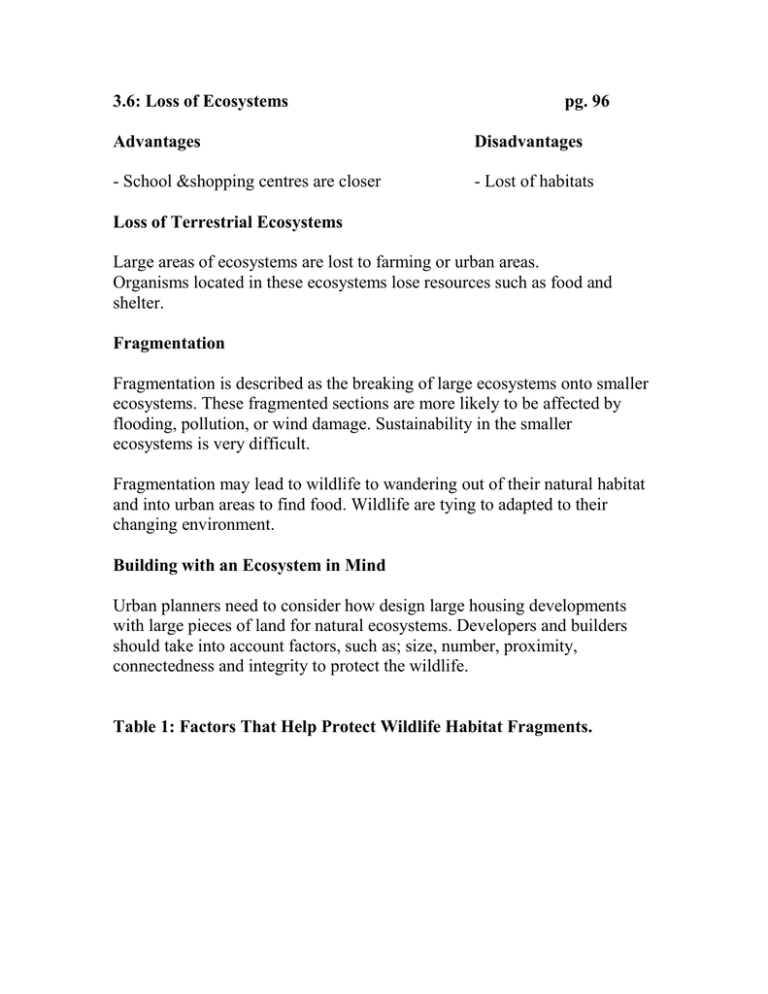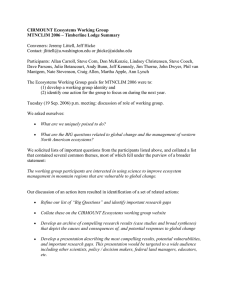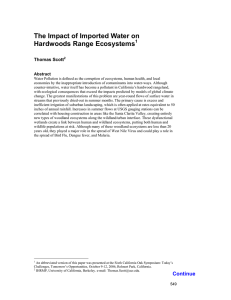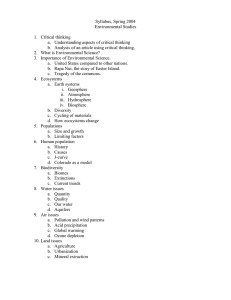3.6: Loss of Ecosystems pg. 96 Advantages
advertisement

3.6: Loss of Ecosystems pg. 96 Advantages Disadvantages - School &shopping centres are closer - Lost of habitats Loss of Terrestrial Ecosystems Large areas of ecosystems are lost to farming or urban areas. Organisms located in these ecosystems lose resources such as food and shelter. Fragmentation Fragmentation is described as the breaking of large ecosystems onto smaller ecosystems. These fragmented sections are more likely to be affected by flooding, pollution, or wind damage. Sustainability in the smaller ecosystems is very difficult. Fragmentation may lead to wildlife to wandering out of their natural habitat and into urban areas to find food. Wildlife are tying to adapted to their changing environment. Building with an Ecosystem in Mind Urban planners need to consider how design large housing developments with large pieces of land for natural ecosystems. Developers and builders should take into account factors, such as; size, number, proximity, connectedness and integrity to protect the wildlife. Table 1: Factors That Help Protect Wildlife Habitat Fragments. Habitat Loss around the World Here in Ontario, we have severe habitat loss, but this is slowly changing. Society is taking a more important role in planning and protecting, monitoring and managing ecosystems. Worldwide habitat loss is of greater concern. Africa, Latin America and the Caribbean are areas that are experiencing rapid industrial and population growth. People gather in areas which supply the most food, work and shelter. This is usually in areas most fertile. This land is then converted to agricultural, housing and industrial uses. Therefore natural ecosystems are, such as: rainforests and grasslands are cleared. Loss of Wetlands and Aquatic Ecosystems Human activities also threaten wetlands and aquatic ecosystems, and damage occurs along the shores of lakes and oceans. Freshwater ecosystems are more important and are in greater danger. Wetlands are drained to build cities and for farming. Wetlands support many different species of plants and animals, which will parish if wetlands should disappear. Commercial Fishing Commercial fishing has a negative affect on ecosystems, species loss and habitat destruction. Trawl line fishing has the greatest negative affect because the nets drag along the bottom of the aquatic habitat, destroying the environment and disrupts organisms that live and lay eggs on the ocean floor. Restoring Wetlands There is now a push to correct the destruction and stop draining wetlands. And keep these wetlands healthy. Natural environments are being reestablished to their natural environment and the species are protected. This will increase wildlife diversity in the ecosystem. The Hilliardton Marsh in northern Ontario is a restored 725 hectare wetland, home to two species atrisk, the Coot and the Black Tern. Check Your Learning: Questions 1 – 7, pg. 100 Wrap Up: - Habitat loss is a serious threat to terrestrial and aquatic ecosystems. - Fragmentation reduces the sustainability of ecosystems. - Wetlands have been drained for farming because of the rich soil. - Restoring wetlands habitats to their natural conditions is an important way to protect the biodiversity of the area.







